The Basic Guide to a Benchtop pH Meter
November 10, 2021
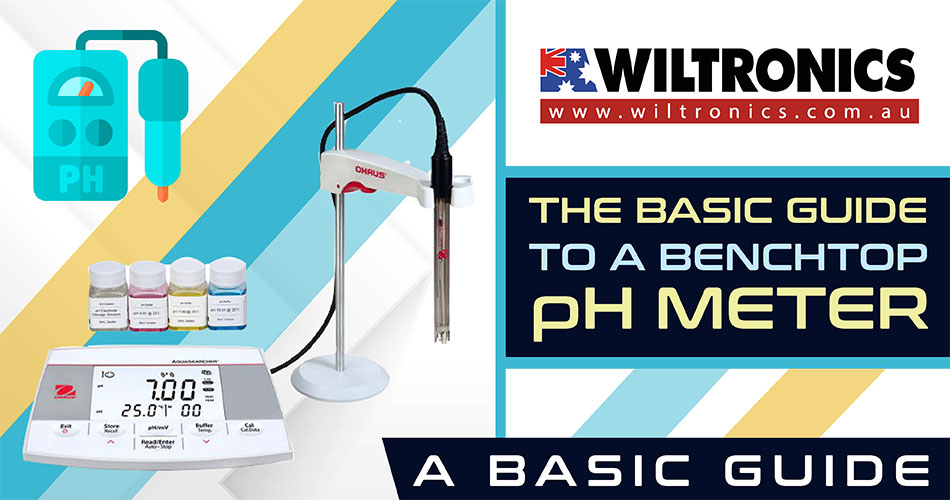
What makes a benchtop pH meter an ideal instrument for measuring acidity or alkalinity?
pH measurements play an important role in a wide variety of applications. This includes agriculture, wastewater treatment, industrial processes, environmental monitoring, and research and development.
They have been, and continue to be, widely used as an accurate measure of the acidity or alkalinity of a solution. Hence why monitoring of pH is vital.
There are a few ways to do the job such as the electrochemical method, a.k.a. pH meter. The benchtop pH meter is a particular version and one of the three main styles of pH meters.
In this post, we unpack the essentials about benchtop pH meters, including the benefits they provide. Read on to check out some of the popular models as well!
What Is pH?
You might be wondering why pH is so important to measure? We thought of giving you a quick overview of what it is and its standard for measuring.
In simple terms, pH stands for “potential for hydrogen“. It is a measurement used to determine the concentration or amount of hydrogen in a solution.
Its value states the relative quantity of hydrogen ions (H+) contained in a solution or area. The greater the concentration of H+ the more acidic the solution and the lower the pH.
In this relationship, pH is also defined as the negative logarithm of hydrogen activity.
The degree of hydrogen ion activity is expressed as the pH level. The general breakdown of pH levels is listed below:
- Neutral solution: pH = 7
- Acidic solution: pH < 7
- Basic solution: pH > 7
pH is generally measured on a scale from 1 to 14. Numbers 1 to 6 on the scale are considered acidic, with 1 being the most acidic.
Pure water is considered neutral when it has a pH of 7. Numbers 8 to 14, in contrast, are considered alkaline or basic, with 14 being the most alkaline.
pH in gardening
Let us use pH in gardening as an example. pH plays a crucial role in the success of a plant’s ability to absorb nutrients and grow.
If the soil is too acidic or alkaline, the greens (in most cases) will not have access to the nutritional value they need to thrive. So, what is the best pH for soil?
For most plants, the optimum pH range is from 6.0 to 7.0. But keep in mind some plants will grow in more acidic or alkaline soil levels.
The pH is not a sign of fertility, but it does affect the availability of fertiliser nutrients.
What happens when there is an unbalanced pH?
Still taking gardening as a the case in point, plants need an ideal environment to grow. On top of sunlight and water, the nutrients available in the soil is also a factor.
When the soil pH is unbalanced (too acidic or alkaline) for a particular plant, chances are (in most cases):
- Seeds may not grow at all.
- Plants might only grow to a fraction of their average size.
- They may not bear fruit or flowers as frequently as the nourished ones.
- They could eventually wither and die.
So, how do you fix it? This is where pH strips and pH meters come into the picture.
pH Strips vs Meters
pH strips are one way to monitor and measure pH level. They are basically pieces of paper that change colour depending on the pH.
Most common pH strips are designed to test urine, water and saliva. There are a wide variety of pH strips available, differing by sensitivity and what range of pH they are designed for.
They are ideally used for testing soil and water. But how do they work?
Dip the test strips for two seconds in the fluid or area which you want to control, then wait for ten seconds. The more acidic, the redder the strip becomes. The more alkaline, the bluer the strip becomes.
Here comes the tricky part: there are events when it can be difficult to figure out whether your strip is reddish or bluish. And while pH strips can give accuracy and precision, they are still inferior to pH meters.
On the flip side, pH meters are electric devices used to measure hydrogen-ion activity (acidity or alkalinity) in solution. The main difference between a meter to a strip is it is a speedy device.
How does it work? A pH meter comes in three different parts:
- Internal electrode
- Reference electrode
- High input impedance meter
The glass probe often contains two electrodes: internal and reference. Inside the probe is a buffer solution at a pH of 7.
Measured pH is the difference in [H+] between the reference buffer inside the probe and the sample solution.
As mentioned earlier, a benchtop pH meter is one of the main design types of pH meters. Let us now define what is it, how it works, and what makes it a great choice for measuring pH.
Defining Benchtop pH Meter
As the name implies, this type of pH meter suggests benchtop usage, but some designs can also be mounted on a wall. When compared to other designs, benchtop meters are more sophisticated and sturdy devices.
They provide greater accuracy, a higher capacity for data storage and more connectivity options. These features make them well-suited to laboratory environments. But they are also widely used in manufacturing applications and industrial uses.
A typical benchtop pH meter consists of measuring and reference electrodes, and a meter. The measuring electrode is hydrogen ion [H+] sensitive and measures pH.
A variety of benchtop pH meters are available with different combinations of measurement modes. This includes pH, mV, ion, and conductivity, ranging from economical to high-end for low-tolerance measurement needs.
The Key Benefits of a Benchtop pH Meter
A benchtop pH meter differs from alternative versions of pH meters, such as strips and handheld models. Compared to these, benchtop units possess the following advantages:
- Greater accuracy. Benchtop pH meters are reliable, delivering high accuracy measurements. This is especially true when compared with strips.
- Sturdy and efficient. Sitting on a bench significantly decreases the risk of meter damage. High-quality units also come with an electrode holder arm, reducing the chance of sample spillage.
- Greater variety of electrodes. There are a wider variety of compatible electrodes compared to other types of meters.
- More memory. Benchtop pH meters often have more data logging and calibration memory. This is a big plus if GLP (Good Laboratory Practices) is an important consideration in your selection process.
- Greater connectivity. Some models may even provide you with the option to download data on your computer or print results. This benefit is perfect for long term data retention as well as in GLP.
- Calibration options. Another positive point for bench meters is they offer more calibration points. The more calibration points a unit has, the greater the post-calibration accuracy.
Examples of Benchtop pH Meters
Our team has compiled a list of bench meters that demonstrate different types of design. We also have broken down their degrees of accuracy, memory and electrode compatibility.
Note: When you are purchasing a benchtop pH meter, there are a few essential things you should consider. This includes Accuracy, Calibration, Electrodes, Temperature, and Portability.
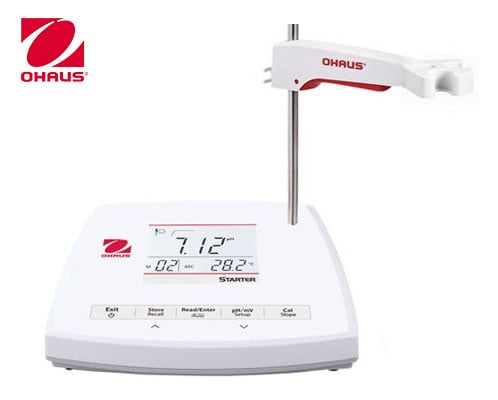
1. Starter™ ST2200-B pH Benchtop Meter
Product code: LQ4322-B
This benchtop meter is a reliable and efficient addition to basic laboratories or science classrooms. It has a simple, user-friendly interface and can store up to 99 items in its internal memory.
It features auto-buffer recognition and auto-endpoint modes. Thus, making measurement and calibration simple, straightforward, and efficient.
The Starter ST2200-B is an affordable benchtop pH meter ideal for basic lab use. Other design features include:
- Auto buffer recognition
- Electrode condition icon
- Temperature compensation
- Accuracy: ±0.5 °C; ±0.01 pH; ±1.5 mV
- Memory: 99
- Calibration points: 2 points
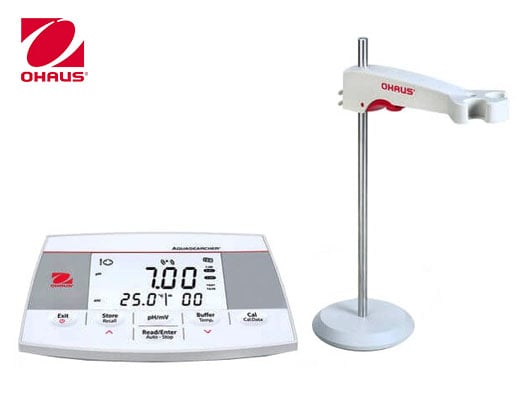
2. Aquasearcher™ AB23PH-B pH Benchtop Meter
Product code: LQ4323PH-B
This benchtop meter is easy and convenient to use. It features a large LCD display and six instructional menu buttons.
The auto buffer recognition and 3-point calibration capability ensure a consistent calibration result. Moreover, the AB23PH-B’s stand-alone holder increases flexibility, making it an ideal space-saving bench meter for the lab.
It also has a 99-item memory to ensure efficient data documentation. Other features include:
- Accuracy: ±0.5 °C; ±1 mV; ±0.01 pH
- Memory: 99
- Calibration points: 3 points
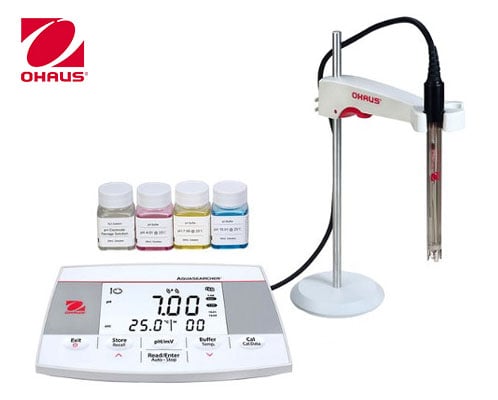
3. Aquasearcher™ AB23PH-F pH Benchtop Meter
Product code: LQ4323PH-F
This next model of bench meter from Aquasearcher comes with an ST320 Probe. Plus, with four 50ml pH buffer mini kits.
Like the AB23PH-B, it features a large LCD Display and six instructional menu buttons. The kit is also equipped with a standalone holder, an auto buffer recognition and 3-point calibration capability.
Other features include:
- Accuracy: ±0.5 °C; ±1 mV; ±0.01 pH
- Memory: 99
- Calibration points: 3 points
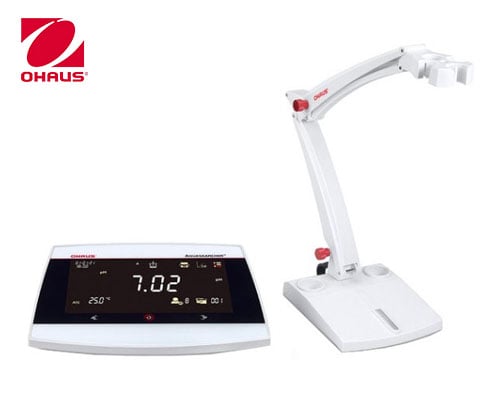
4. Aquasearcher™ AB33PH-B pH Benchtop Meter
Product code: LQ4333PH-B
With multifunctional touch keypads, this all-new Aquasearcher AB33 makes measurement simple and fast within 3 steps. Paired with a large LCD, they make changing parameters, executing setup, and performing calibration as simple as using a smartphone.
The i-Steward also guarantees repeatable and consistent measurement accuracy. It is highly reliable, user-friendly, and ideal for standard laboratory applications.
Other features include:
- Accuracy: ±0.5 °C; ±1 mV; ±0.01 pH
- Memory: 1,000 measurement memory
- Calibration trail perfect for efficient data documentation
If you are looking for an AB33 unit that comes with a probe and 4 × 50ml pH buffer mini kits, check out this product code: LQ4333PH-F.
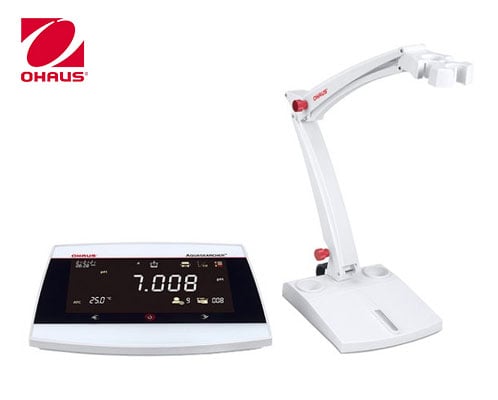
5. Aquasearcher™ AB41PH-B pH Benchtop Meter
Product code: LQ4341PH-B
The AB41PH-B model is an advanced, research-grade benchtop pH meter from Aquasearcher. It is ideal for pH, oxidation-reduction potential (ORP) with temperature measurements applications.
This unit also features a 6.5″ Segment & Dot matrix LCD with a backlight. Other design features include:
- i-Steward
- 3 endpoint modes
- Calibration due alarm
- Password management
- Accuracy: ±0.3 mV; ± 0.002 pH; ±0.3 °C
- 1,000 measurement memory
- Calibration points: 10
You also might like…
We also have a few models that feature probes and 4 x 50ml pH buffer mini kits.
- Aquasearcher™ AB41PH-F pH Benchtop Meter with ST410 Probe (Product code: LQ4341PH-F)
- Starter™ ST2200-F pH Benchtop Meter with ST320 Probe (Product code: LQ4322-F)
The Bottom Line
It is clear that the pH meter is an essential component of science and that it plays a big role in our lives. For one, it is used to measure acidity levels in wastewater, which is vital in the water treatment process.
It is also used to analyse the exact pH value of food-grade and chemical products to ensure safety and quality. When it comes to gardening, it helps us to grow nutritious plants and veggies that we, later on, serve on the table.
On top of these, a pH meter is a great tool for evaluating the acidity or alkalinity of drugs in the pharmaceutical and biotechnology industries. And with a benchtop pH meter, it makes measuring pH levels a lot easier and more convenient!
Looking for more quality pH and water meters to meet your needs? Shop the full pH measurement range here and find the perfect pH meter to suit your application and budget!
© Electrotech Brands Pty Ltd 2021


Write a Comment
You must be logged in to post a comment.